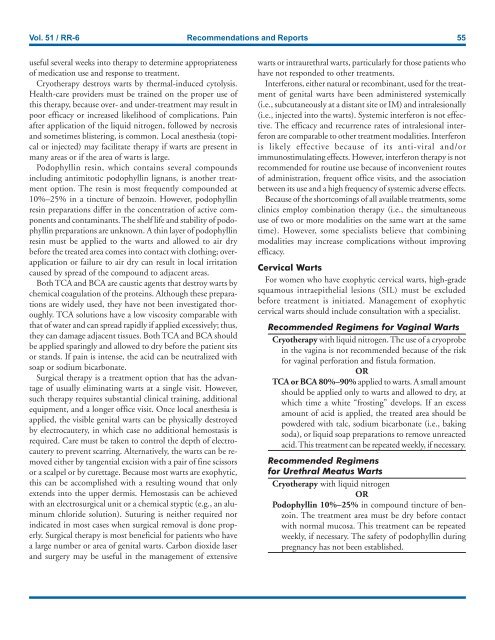Create successful ePaper yourself
Turn your PDF publications into a flip-book with our unique Google optimized e-Paper software.
Vol. 51 / RR-6 Recommendations and Reports 55<br />
useful several weeks into therapy to determine appropriateness<br />
of medication use and response to treatment.<br />
Cryotherapy destroys warts by thermal-induced cytolysis.<br />
Health-care providers must be trained on the proper use of<br />
this therapy, because over- and under-treatment may result in<br />
poor efficacy or increased likelihood of complications. Pain<br />
after application of the liquid nitrogen, followed by necrosis<br />
and sometimes blistering, is common. Local anesthesia (topical<br />
or injected) may facilitate therapy if warts are present in<br />
many areas or if the area of warts is large.<br />
Podophyllin resin, which contains several compounds<br />
including antimitotic podophyllin lignans, is another treatment<br />
option. The resin is most frequently compounded at<br />
10%–25% in a tincture of benzoin. However, podophyllin<br />
resin preparations differ in the concentration of active components<br />
and contaminants. The shelf life and stability of podophyllin<br />
preparations are unknown. A thin layer of podophyllin<br />
resin must be applied to the warts and allowed to air dry<br />
before the treated area comes into contact with clothing; overapplication<br />
or failure to air dry can result in local irritation<br />
caused by spread of the compound to adjacent areas.<br />
Both TCA and BCA are caustic agents that destroy warts by<br />
chemical coagulation of the proteins. Although these preparations<br />
are widely used, they have not been investigated thoroughly.<br />
TCA solutions have a low viscosity comparable with<br />
that of water and can spread rapidly if applied excessively; thus,<br />
they can damage adjacent tissues. Both TCA and BCA should<br />
be applied sparingly and allowed to dry before the patient sits<br />
or stands. If pain is intense, the acid can be neutralized with<br />
soap or sodium bicarbonate.<br />
Surgical therapy is a treatment option that has the advantage<br />
of usually eliminating warts at a single visit. However,<br />
such therapy requires substantial clinical training, additional<br />
equipment, and a longer office visit. Once local anesthesia is<br />
applied, the visible genital warts can be physically destroyed<br />
by electrocautery, in which case no additional hemostasis is<br />
required. Care must be taken to control the depth of electrocautery<br />
to prevent scarring. Alternatively, the warts can be removed<br />
either by tangential excision with a pair of fine scissors<br />
or a scalpel or by curettage. Because most warts are exophytic,<br />
this can be accomplished with a resulting wound that o<strong>nl</strong>y<br />
extends into the upper dermis. Hemostasis can be achieved<br />
with an electrosurgical unit or a chemical styptic (e.g., an aluminum<br />
chloride solution). Suturing is neither required nor<br />
indicated in most cases when surgical removal is done properly.<br />
Surgical therapy is most beneficial for patients who have<br />
a large number or area of genital warts. Carbon dioxide laser<br />
and surgery may be useful in the management of extensive<br />
warts or intraurethral warts, particularly for those patients who<br />
have not responded to other treatments.<br />
Interferons, either natural or recombinant, used for the treatment<br />
of genital warts have been administered systemically<br />
(i.e., subcutaneously at a distant site or IM) and intralesionally<br />
(i.e., injected into the warts). Systemic interferon is not effective.<br />
The efficacy and recurrence rates of intralesional interferon<br />
are comparable to other treatment modalities. Interferon<br />
is likely effective because of its anti-viral and/or<br />
immunostimulating effects. However, interferon therapy is not<br />
recommended for routine use because of inconvenient routes<br />
of administration, frequent office visits, and the association<br />
between its use and a high frequency of systemic adverse effects.<br />
Because of the shortcomings of all available treatments, some<br />
clinics employ combination therapy (i.e., the simultaneous<br />
use of two or more modalities on the same wart at the same<br />
time). However, some specialists believe that combining<br />
modalities may increase complications without improving<br />
efficacy.<br />
Cervical Warts<br />
For women who have exophytic cervical warts, high-grade<br />
squamous intraepithelial lesions (SIL) must be excluded<br />
before treatment is initiated. Management of exophytic<br />
cervical warts should include consultation with a specialist.<br />
Recommended Regimens for Vaginal Warts<br />
Cryotherapy with liquid nitrogen. The use of a cryoprobe<br />
in the vagina is not recommended because of the risk<br />
for vaginal perforation and fistula formation.<br />
OR<br />
TCA or BCA 80%–90% applied to warts. A small amount<br />
should be applied o<strong>nl</strong>y to warts and allowed to dry, at<br />
which time a white “frosting” develops. If an excess<br />
amount of acid is applied, the treated area should be<br />
powdered with talc, sodium bicarbonate (i.e., baking<br />
soda), or liquid soap preparations to remove unreacted<br />
acid. This treatment can be repeated weekly, if necessary.<br />
Recommended Regimens<br />
for Urethral Meatus Warts<br />
Cryotherapy with liquid nitrogen<br />
OR<br />
Podophyllin 10%–25% in compound tincture of benzoin.<br />
The treatment area must be dry before contact<br />
with normal mucosa. This treatment can be repeated<br />
weekly, if necessary. The safety of podophyllin during<br />
pregnancy has not been established.


